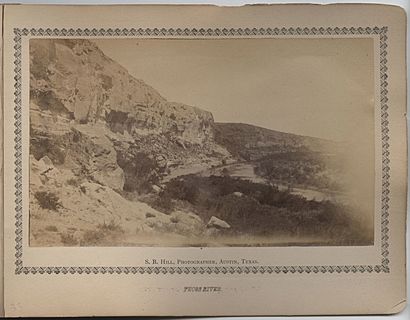Pecos War facts for kids
Quick facts for kids Pecos War |
||||
|---|---|---|---|---|
| Part of the Range Wars and American Indian Wars | ||||

The Pecos River in the 1880s, which gave the conflict its name
|
||||
| Date | 1876 - 1877 | |||
| Location | ||||
| Caused by | Stock and grazing and dispute | |||
| Resulted in | Inconclusive | |||
| Parties to the civil conflict | ||||
|
||||
| Lead figures | ||||
|
||||
| Number | ||||
|
||||
| Casualties | ||||
|
||||
The Pecos War, also known as the War of the Pecos or the Chisum War, was a conflict over land and cattle. It happened from 1876 to 1877 along the Pecos River in New Mexico. A very rich rancher named John Chisum fought against smaller ranchers, farmers, and Mescalero Apache Native Americans.
The main reason for the conflict was competition for land and resources. Chisum believed that people were stealing his cattle and using his land. At the same time, Chisum was also fighting the Mescalero Apaches from nearby reservations. He said they were also taking his cattle.
Contents
Why the Pecos War Started
In 1876, John Chisum moved from Roswell to claim a large area of grasslands along the Pecos River. He wanted this land for his huge cattle business. However, his claim caused problems with several smaller ranching families. These families had moved from Texas the same year. It also caused issues with the Apache people living at the nearby Mescalero Indian Reservation.
Back then, much of the frontier land was open to anyone who claimed it first. Large herds of cattle roamed freely. Ranchers identified their cattle using special brands. Chisum and his Jinglebob Ranch took over much of the best land for grazing.
Chisum called the smaller ranchers "little fellows." He thought many of them were "rustlers," meaning they were stealing his cattle to sell. To protect his property, Chisum hired armed cowboys and ranch hands. These men were led by James M. Highsaw, who was known for being very quick and calm in tough situations. Some of Chisum's men, like Tabb and Charles Rankin, were shot at by his enemies.
Many of the smaller ranch communities formed a group called the Seven Rivers Warriors. They wanted to defend themselves against Chisum. This group included people like Buck Powell, Dick Smith, and the Beckwith family. Both the Seven Rivers Warriors and the Mescalero Indian Reservation were connected to Chisum’s rivals, the House and the Santa Fe Ring.
Key Events of the War
The first fight happened in October 1876 at the Wiley Cow Camp. This camp was about 80 miles from Chisum’s ranch. A man named Yopp argued with two cowboys. Yopp grabbed his rifle and shot at them. But cowboy Buck Powell shot back and killed Yopp.
On March 10, 1877, James Highsaw faced Dick Smith at a cow camp on Loving’s Bend. Highsaw had proof that Smith was stealing cattle. Smith tried to grab his gun, but Highsaw was faster and killed him. Highsaw was later cleared of any wrongdoing because it was seen as self-defense.
About a month later, Chisum rode out with thirty armed men to the home of the Beckwith family. They surrounded the house from about 500 yards away. They cut off the water supply and told the Beckwiths to give up. The Beckwiths, however, started shooting back. Two men inside the house, Charles Woltz and Buck Powell, secretly slipped out to get help. After a night of fighting, Chisum’s cowboys told him to pull back. They said they were hired to herd cattle, not to get shot.
Fights with Native Americans
At the same time, Chisum was also fighting with the Apache people. He claimed they had stolen his cattle and attacked his men. Earlier, in 1873, Chisum had lost many horses, mules, and other animals. In the fall of 1877, Chisum’s men went to the reservation to get back stolen horses. It was said that Chisum’s men killed many Apache people and took many of their horses. An official called Indian Inspector Erwin C. Watkins looked into this and confirmed that Chisum’s men had taken the Apache horses.
What Happened Next
In June, Chisum was put on trial for various charges, including gathering people illegally and stealing. Smaller ranchers also brought charges against him. However, none of the charges stuck, and they were all dropped. The Pecos War ended without a clear winner. The conflict between Chisum and the smaller ranchers continued later during the Lincoln County War.

